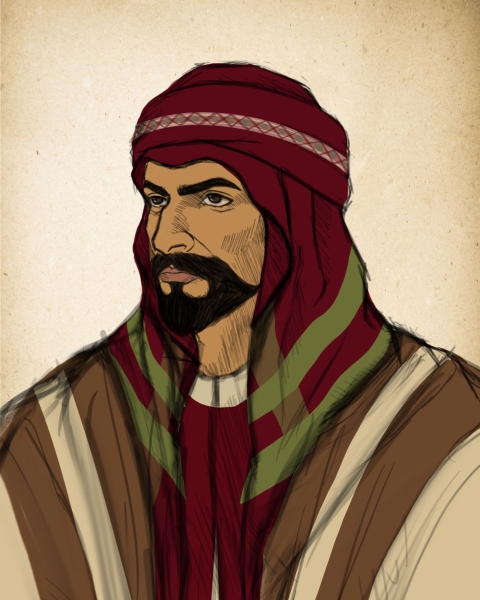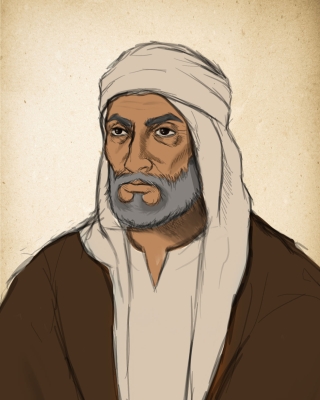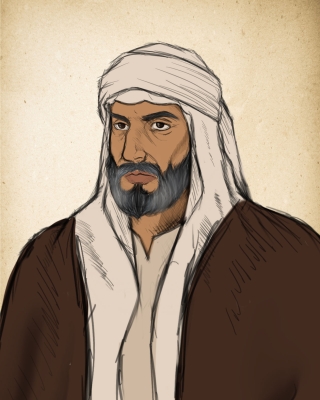

Imam Abdullah Bin Saud Bin Abdulaziz Bin Mohammad Bin Saud (1771 - 1818) was the fourth and last Imam of the First Saudi State. The end of his rule marked the end of the First Saudi State, after a siege on Diriyah that lasted for about six months. During this time, it withstood attacks from the Ottoman Empire. He surrendered and left the city, seeking reconciliation to stop the bloodshed and preserve the safety of its people.
Upbringing of Imam Abdullah Bin Saud
Imam Abdullah Bin Saud was born in Diriyah in 1771. He mastered horsemanship from a young age, becoming one of the renowned knights. His father, Imam Saud, would delegate him to manage the state when he was away from Diriyah. He also led some armies in certain battles during his father's reign, notably in the Battle of al-Safra against Tusun Pasha in 1811, achieving a significant victory.
Imam Abdullah Bin Saud's assumption of power
Imam Abdullah Bin Saud assumed power after the death of his father in 1814. At that time, he was engaged in fighting Ottoman forces in Hejaz. He received news of his father's death upon reaching Upper Najd. His army men offered condolences and pledged allegiance to him. He continued his journey to Diriyah, where its inhabitants pledged allegiance to him, and delegations from supporters and loyalists came to him.
During the reign of Imam Abdullah Bin Saud, which lasted for five years, there was a series of battles aimed at preserving the security of the Saudi State. This resulted in a slowdown in scientific and social advancement during that period. However, religious education remained vibrant since the era of Imam Saud, who laid down principles to combat illiteracy and promote mandatory education. In every region, scholars were teaching religious and Arabic sciences in mosques or houses. Diriyah was the largest center for religious education in the Saudi State, attracting students of knowledge from all regions.
Imam Abdullah Bin Saud's battles
Imam Abdullah, during his raids, called upon the tribes not to cooperate with the enemies. He sent the chief of the Otaibah tribe, Ghassab Al-Otaibi, to take over the general command and the military formations around Turubah, a crucial point in defending the state, and then returned to Diriyah. He prepared his forces and organized a military campaign led by his brother Faisal, which moved towards Turubah. This campaign was joined by all the loyal forces and tribes from the Hejaz, Tihama, and elsewhere. In November 1814, large forces reached Makkah al-Mukarramah, along with supplies for Mohammed Ali Pasha.
Prince Faisal arrived at Byssel to confront the Ottomans who were encamped there. A battle took place, and during it, Mohammed Ali Pasha advanced with his forces, forcing Prince Faisal to withdraw in the face of this power. Mohammad Ali Pasha then occupied Turbah and marched on to Khamis Mushayt, Bishah, and the rest of their villages, as well as the villages of the Aseer and Rijal Alma, and the Rufaydah tribes. Mohammad Ali Pasha also sent Sharif Rajih - who later joined his ranks - to the town of Ranyah. While Mohammed Ali was advancing towards the Saudi cities, he received news of a dispute between his government and the Mamluks, so he returned to Egypt after ordering his son, Tusun, to march on Qassim.
Tusun began marching to Najd, occupying cities and villages along his way. However, the situation did not last, and the tide of battle swung from victory to defeat for both sides. Then, Tusun sent a messenger to Imam Abdullah requesting reconciliation, which Imam Abdullah accepted on the condition of ceasing hostilities and ending Ottoman intervention in Najd. Subsequently, the Ottoman forces left the town of Al-Rass in Najd for al-Madinah al-Munawwarah. Accompanying Tusun on his return were two representatives from Imam Abdullah, carrying a message to Mohammed Ali Pasha, who endorsed the reconciliation.
After reconciliation and Tusun's withdrawal, Imam Abdullah returned to Diriyah victorious. Tusun died in Egypt not long after. Imam Abdullah then resumed forming the administrations of some tribes and the inhabitants of cities and villages, appointing princes there. To reaffirm his commitment to the agreement to Mohammed Ali Pasha, he sent Hassan Bin Mazrou' and Abdullah Bin Aoun, along with his messages and gifts, as confirmation. However, for Mohammed Ali, the agreement was merely a truce imposed by circumstances. The envoys of Imam Abdullah revealed that he was plotting something against the Saudi State, and they conveyed to him what they had witnessed during their journey and meeting with the governor (vali) of Egypt.
The Siege of Diriyah
Mohammed Ali Pasha amassed armies, and the Ottoman Empire supplied him with men, equipment, and money. In 1815, his son Ibrahim Pasha led these forces towards al-Madinah al-Munawwarah, where his troops were stationed. From there, they advanced to al-Hanakiyyah, attempting to sway the tribes to his side, sometimes through displays of force and at other times through money and gifts. He carried out several swift attacks on certain tribes to demonstrate his forces' readiness and numbers. After assembling a considerable force, he directed his troops towards Diriyah, employing a military plan that involved bombarding the walls and fortresses day and night with cannons. This tactic intimidated the tribes, leading some to seek peace, while others withdrew to join Imam Abdullah, who was hindering Ibrahim Pasha's advance. He moved from city to city, organizing his army's ranks and directing his commanders. However, the continuous arrival of supplies, equipment, men, and provisions from Egypt bolstered Ibrahim Pasha's ranks and boosted his army's morale.
On March 10, 1818, Ibrahim Pasha was on the outskirts of Diriyah, settling in the village of al-Malqa, where there were palm groves belonging to Imam Abdullah. He settled in this village, which is an hour's walk from Diriyah. He camped there, and after a short period, he moved towards the village of al-Ulab. From there, he began to fire his cannons at the palm groves and walls of Diriyah to expose them. He found that the people of Diriyah had prepared for his attack and faced fierce resistance, forcing him to retreat to his headquarters in al-Malqa. After three days of planning, he directed all his forces and moved towards the village of al-Ulab once again, dividing his forces between the center of the valley, its banks, and Diriyah's eastern heights behind the valley where his command post was located. On the other side of Diriyah and its palm groves, Imam Abdullah Bin Saud was planning his defense strategy and deploying his forces.
The two armies met in scattered encounters of advance and retreat, and the battles continued for ten days. During this time, Ibrahim Pasha was unable to advance towards Diriyah, which forced him to halt and take up new positions. He then resumed bombing the Saudi positions. Successive and advanced supplies reached Ibrahim Pasha, tipping the balance as the forces were no longer equal. The siege caused the provisions in Diriyah to run out, and ammunition dwindled due to the ongoing war, leading some tribes to leave Diriyah. At that time, Imam Abdullah tried to fill the gaps in his ranks as much as possible and positioned himself in the center of Diriyah with some of his men. However, seeing hundreds of casualties among the people of Diriyah, he decided to leave Diriyah for the safety of the residents.
The end of the First Saudi State
The end of the First Saudi State came with Imam Abdullah Bin Saud's departure from Diriyah and his surrender to the Ottoman campaign's commander, Ibrahim Pasha, after a six-month siege. Ibrahim Pasha did not honor his promise; after the surrender of Diriyah, he entered it as a combatant, persecuted its notables and scholars, and killed them with bullets and cannons. Furthermore, an order from his father, Mohammed Ali Pasha, arrived to completely destroy Diriyah. He began bombarding it with his cannons until it was reduced to ruins.
Death of Imam Abdullah Bin Saud
Ibrahim Pasha prepared a force that accompanied Imam Abdullah to Egypt along with some members of his family, then to the Ottoman Empire in Istanbul. He was killed in the Beyazit Square by order of its Sultan Mahmud Khan in 1818.
Related quizzes
Related articles

